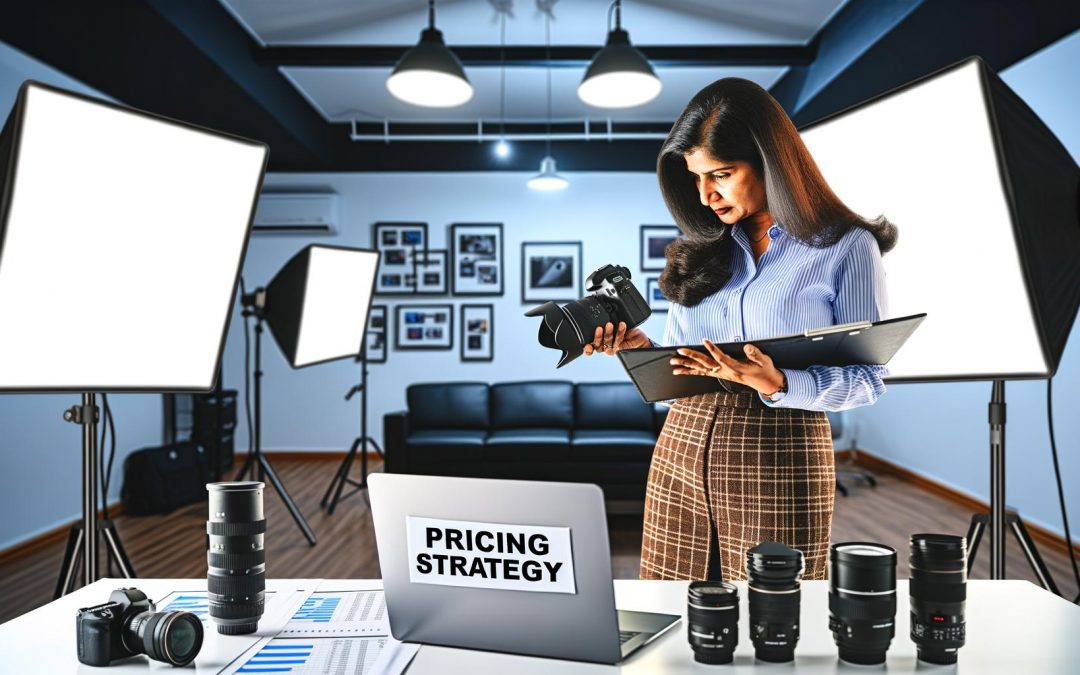Understanding how to price your photography services is crucial for building a profitable business. Knowing the right techniques and having up-to-date equipment are essential in this process. Let’s explore strategic approaches to set your pricing for optimized success.
Understanding Your Worth
Recognising your worth is essential for pricing your photography.
Pause a moment. Reflect on your own skills and experience. Your photography might capture the joyful chaos of a wedding, or the serene beauty of a landscape. But what makes your work unique? Is it the way you play with natural light or perhaps your knack for capturing candid moments with authenticity? Aligning such unique attributes with your pricing validates your value.
New trends in the photography field offer further opportunities to elevate your worth. Master techniques like the bokeh effect and explore creative self-portrait ideas. These contribute to your signature style, thus driving your perceived value higher. Learn how to master the bokeh effect here.
But, explore and experiment further. This curiosity enhances not just breadth, but depth of your skillset. Aligning these with market trends, your growing expertise will naturally reflect how you price your photography. Push beyond—because sometimes, the unexpected is exactly where new value lies.
Researching Market Trends
Knowing what others are doing in the photography field is critical.
Dive into the depths of market research like a gold miner. That means scrutinising competitor pricing and paying attention to what clients really want. Imagine you’re eyeing the latest Canon or Nikon camera. Suddenly, understanding the pricing windfalls is clearer.
Next time you giggle through Instagram, notice which lenses or styles are trending among your peers. Maybe it’s Sony’s A7R series or another tech marvel. Staying updated ensures you’re not just following the crowd but leading it, too.
Harness new techniques and gear that enhance your work. Clients notice your tools and talents over time. It makes a difference. Balancing quality with competitive pricing? That’s your sweet spot. Here’s a quick tip, check out these photography composition techniques. Finding this balance means comparing peer work and defining what makes your service unique. That’s a powerful strategy for setting your prices.
Creating Your Pricing Structure
Pricing your photography services is an art form.
Establishing a pricing structure requires thought. There are various models, each with unique applications. An hourly rate caters to clients seeking flexibility. It benefits short events or sporadic shoots. Project-based pricing is perfect for assignments with defined objectives. They’re neat, and I find they appeal to corporate clients. Some love the order packages bring. They offer the familiarity of a set menu, with customisation available.
It’s essential to communicate openly with clients about your fees. Transparency nurtures trust. When equipped with cutting-edge techniques, like superior Lightroom skills, enhance perceived value. Clients notice every detail. You can check out this guide to street photography for more insights. Pricing isn’t just numbers on a page. It’s an opportunity to highlight your distinct value, even if your approach seems casual or might feel unfinished.
Communicating Value to Clients
Communicating value is the secret to justifying your prices.
Think of it like this, when clients look at your work, what makes them say, “I need this photographer”? It’s not just the photos. It’s the craft, the purpose behind each shot. You need to convey the artistry and insight your work embodies. That’s where pricing becomes less about numbers and more about understanding.
One way to reinforce this is by sharing how your advanced equipment, like the Canon EOS R5, elevates their experience. Mentioning the use of precision lenses and your meticulous post-processing details can make a difference.
Educate them about your techniques without crossing the line into jargon overload. Like guiding a friend, explain it in familiar terms. Clients appreciate knowing what goes into creating those unforgettable shots. They’ll recognise your service as an investment, not an expense.
And you know what? Sometimes it’s just a matter of allowing them to see the passion, the hours, the dedication you’ve crafted into your art. It’s that transparency that sways them, more than anything else. Make it a conversation, not a sales pitch. They’ll see the worth and, with a bit of trust, the price becomes just a detail.
When the value is clear, the numbers become secondary. That’s a bit cliché, but isn’t that often the truth? And if you keep this in mind, after all, they chose you for a reason—help them realise what that reason is too.
Adjusting and Updating Your Pricing
Adjusting your photography pricing is necessary.
Now, why is this so vital? Think about it, the world around us keeps moving. Prices change, industries shift, and our own skills grow like fine wine. So, it makes sense to revisit how you charge for your craft. When’s the right time, though? Perhaps after completing a new photography course or when you’ve added a signature style to your repertoire. Tackling this isn’t just about slapping on a random increase. It’s a blend of keeping an eye on market trends and tapping into the pulse of client feedback.
Always keep learning. Feedback isn’t just clients jibbing, it’s crucial intel. Perhaps try surveying clients after assignments to pinpoint where value hits or misses. And don’t go it alone, seek out mentors who’ve navigated these waters before. There’s no harm in asking for guidance.
Alright, enough sitting around. If you’re seeking expert guidance to refine your strategy, do reach out.
Final words
Pricing your photography services involves understanding your value, gauging market trends, and staying updated with new techniques. By setting competitive pricing, you can attract the right clients while growing your business. Remember, clarity and confidence in your pricing will empower you to succeed. Click [here](https://www.alexsmale.co.uk/contact/) to get professional guidance.

